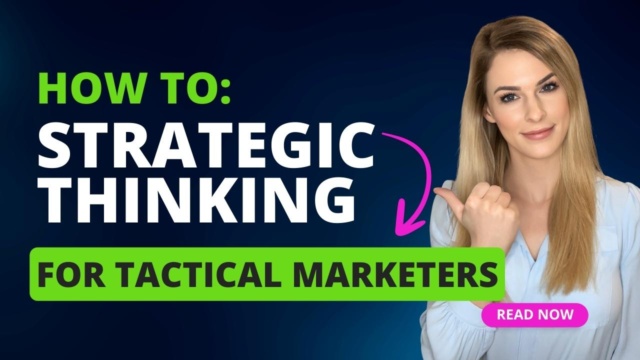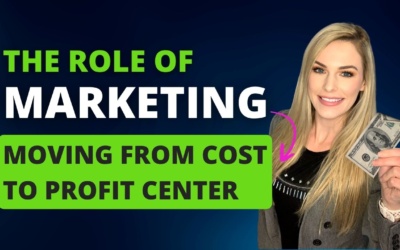Does this sound familiar?... You’ve been an individual contributor most of your career - and a good one at that! You’ve been able to optimize marketing processes, run campaigns, and generate great results for the business.
You’re ready to move up in your career to a senior leadership role and express your interest to your leader. However, the brakes get pumped. “I believe in you, but you need to be more strategic…”
…Ouch! What does that mean?
You’ve been a deep thinker and a top performer your entire career, so how are you not strategic?
I’m here to tell you that I’ve been there too! Sometimes it’s not a matter of not being strategic but understanding how to properly display it to your team and leadership. Hearing this can be a blow to the ego; however, understanding how to develop and showcase this skill will pay off massively in your career growth and the growth of your organization.
Making the shift from a top-performing individual contributor to a strategic leader is a common struggle for not just marketers but ambitious young leaders as a whole.
Table of Contents
What is Strategic Thinking?
Simply put - strategic thinking is long-term planning for the future. And not just a yearly marketing strategy - it’s about thinking three or even five years ahead and how your decisions now will make an impact then. It’s more about vision-casting for your businesses than the month-to-month or week-to-week tasks. Here are some more ways to think about strategic thinking:
- Thinking about how your team affects your entire organization and stakeholders (not just the marketing department)
- Having a deep understanding of your industry and anticipating trends and opportunities
- Having the experience to sometimes make tough calls to reach your team’s goals and working within resource limitations
- Inspiring people and creating a vision of what’s possible
- Experimenting, taking informed risks, and pushing towards ambitious targets
Here’s the good news - you’re already a high performer and most likely a deep thinker, so strategic thinking is not out of reach, and it’s possible to develop (you don’t need to be born with it!). It just requires practice.
How to Become a Strategic Marketing Leader
Suppose you’re an individual contributor, and your day is packed with meetings and action items. In that case, it will be almost IMPOSSIBLE to start thinking big-picture (you simply won’t have time for it!).
Are you caught in this trap? You’re executing marketing campaigns, and so caught up in the day-to-day that you have no more brain power to plan strategically to advance yourself and your team. You’re not alone. I've been there, too (and still find myself in that place many days). In fact, 96% of leaders say that lack of time is the biggest roadblock to thinking strategically.
I’ll share some action items below (very tactical!) that will help clear your headspace to have the time to be strategic.
Delegate To Support Team Growth
If you’re the leader of a team currently, start delegating. Empower and train your team to take on more tasks or even reports. You need a succession plan if you want to move up anyways, right? Start giving your team growth opportunities by allowing them to take on more responsibility. Start by auditing your calendar. Are there meetings you can eliminate or shorten (most meetings can be emails!)? Take control of your calendar and start blocking off “white space” to give yourself time to think. This should NOT just be your scheduled lunch break.
If you don’t manage others, make a habit of clearing space throughout your day that’s strictly dedicated to thinking about big strategy and building on strategy and ideas to share with your team.
Prioritize Your Tiers of Effectiveness
I use an exercise called the 4-tiers of effectiveness with myself and my team. It’s all about visualizing what’s a priority in your role based on your team’s goal. If you don’t go through this exercise, you can find yourself reacting to every message, every email, every shoulder tap, and every request and finding it challenging to be proactive (rather than reactive!). You can download a copy that I made for you here.
As a marketing leader, you know marketing can become a “catch-all” for company support. There will always be new opportunities, new problems, and new requests. So if you truly want to start being strategic, you must be selective on projects and requests that will advance your team’s and business’ core objectives (tier 1 priorities).
Always Offer Solutions, Not Problems
Strategic marketing leaders don’t simply highlight problems and complain - they always take the next step to offer solutions. They will come to the table with proposals and plans for taking action. They speak inspirational language about what’s going well, what could be going better, and what is possible - not simply what’s wrong.
You can practice this skill by coaching your team the next time they come to you with an issue. Let’s say your employee Tim oversees all Google Ads campaigns. He comes to you in a 1 on 1 and exclaims, “I know our goal is to generate 100 leads per month on Google Ads. However, it’s just not happening. Our Google account rep advised we switch to a Target CPA model, and leads have gone down significantly. I just don’t think we can meet our lead goal this month.” How would you coach Tim through this? Here are some questions you could ask him:
- What possibilities have you considered to reach the goal for the month?
- If you were me, how would you approach this challenge?
- Based on your Google Ads experience, what do you propose as a next step?
Based on that feedback, help Tim come up with an action plan. The more you practice this skill with your team and your direct leader, the more it becomes an ingrained part of your thought process.
Be Vulnerable and Build Relationships
Don’t assume strategic marketing should fall solely on you. The most beneficial thing you can do is ask for varying thoughts and opinions from your team and colleagues. You’d be surprised at how much they can contribute (even to marketing ideas!).
When it comes to flexing your strategic gains, getting consensus is important. It’s not only essential to build upon your ideas and make them better, but it’s also important to show leadership that you are thinking strategically about the business and the widespread impacts of your new ideas!
I’ve learned this the hard way from previously working in a lot of startup environments. In a startup, it was important to always be in the “fast lane” where many decisions were made quickly. High risk and fast execution were at the forefront. However, taking a little extra time to run things through the chain and collaborate is how you’ll be viewed as a visionary leader in the long run.
Step-by-Step Strategic Thinking [Infographic]

What Are Your Thoughts?
I’d love to hear what you’ve learned throughout your career on ways to showcase and develop strategic thinking! Let me know in the comments!
Christy Puller is a dynamic leader known for driving profit and revenue through innovative digital marketing strategies. She has built marketing functions from the ground up in both B2B and B2C sectors, scaled teams, and generated over 8 figures ARR and 40-60% YoY growth for multiple industries.
Passionate about SEO, PPC, content strategy, and team leadership, Christy has crafted international and domestic marketing strategies and developed top-tier marketing teams. Holding a Bachelor of Science in Marketing from the University of Central Florida and multiple industry certifications, Christy combines academic rigor with real-world success to empower businesses and mentor future marketing leaders.
Contact [email protected].
Do you want more business revenue?
Hey, I'm Christy Puller. I'm passionate about getting your business on the path to generating revenue through marketing.

About Christy Puller
With over 10 years of strategic marketing experience, Christy is a dynamic leader known for driving profit and revenue through innovative digital marketing strategies. She has built marketing functions from the ground up in both B2B and B2C sectors, scaled teams, and generated over 8 figures ARR and 40-60% YoY growth for multiple industries.










